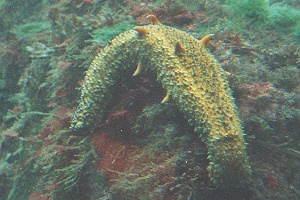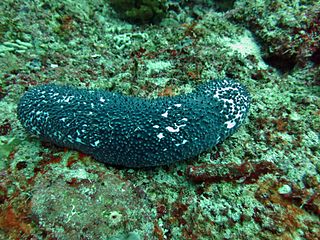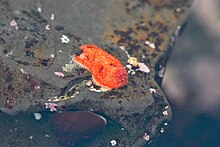
Sea cucumbers are echinoderms from the class Holothuroidea. They are marine animals with a leathery skin and an elongated body containing a single, branched gonad. They are found on the sea floor worldwide. The number of known holothurian species worldwide is about 1,786, with the greatest number being in the Asia-Pacific region. Many of these are gathered for human consumption and some species are cultivated in aquaculture systems. The harvested product is variously referred to as trepang, namako, bêche-de-mer, or balate. Sea cucumbers serve a useful role in the marine ecosystem as they help recycle nutrients, breaking down detritus and other organic matter, after which bacteria can continue the decomposition process.

The California sea cucumber, also known as the giant California sea cucumber, is a sea cucumber that can be found from the Gulf of Alaska to Baja California. It is found from the low intertidal zone to a depth of 250 m (820 ft). They are most abundant in areas with moderate current with cobbles, boulders or bedrock. They are artisanally fished.

Dendrochirotida are an order of sea cucumbers. Members of this order have branched tentacles and are suspension feeders. Examples include Thyonella and Cucumaria.

Apostichopus parvimensis, commonly known as the warty sea cucumber, is a Pacific species of sea cucumber that can be found from the Baja California Peninsula, Mexico, to Monterey Bay, California, USA, although only scattered individuals were reported to occur north of Point Conception, California. It is found mainly in low energy environments from the intertidal zone down to 30 m (98 ft), but can occur as deep as 60 m (200 ft).

Cucumaria miniata is a species of sea cucumber. It is commonly known as the orange sea cucumber or red sea cucumber due to its striking color. This northeast Pacific species is often found wedged in between rocks or crevices at the coast or on docks and can generally be identified by its orange bushy tentacles protruding above the substrate.

Montagu's blenny, also known as the capuchin blenny, is a species of combtooth blenny found in the intertidal zones of the eastern Atlantic ocean from England to Madeira and the Canary Islands as well the Mediterranean Sea, the Black Sea and the Sea of Marmara. This species prefers rocky shores with much wave action. This species grows to a length of 7.6 centimetres (3.0 in) SL. It is the only species in the genus Coryphoblennius.

Psolidae is a family of sea cucumbers, marine animals with elongated bodies, leathery skins and tentacles that are found on the sea bed.

Holothuria forskali, the black sea cucumber or cotton-spinner is a species of sea cucumber in the family Holothuriidae. It is found at shallow depths in the eastern Atlantic Ocean and the Mediterranean Sea. It was placed in the subgenus Panningothuria by Rowe in 1969 and is the type taxon of the subgenus.
Phoronis psammophila is a species of marine horseshoe worm in the phylum Phoronida. It lives in a tube projecting from the sea floor in shallow seas around the world.

Colochirus robustus, commonly known as the robust sea cucumber or the yellow sea cucumber, is a species of sea cucumber in the family Cucumariidae. It is found in shallow seas in tropical parts of the central Indo-Pacific region. C. robustus belongs to the class Holothuroidea, a group of echinoderms called sea cucumbers and known for unusual behavior including evisceration, asexual reproduction, and regeneration. The robust sea cucumber has a soft body and lacks a spine, but it does have an endoskeleton consisting of microscopic spicules, or ossicles, made of calcium carbonate. C. robustus has a respiratory tree that allows it to extract oxygen for respiration, using the anus to pump water. The robust sea cucumber is an important dietary staple for many East and Southeast Asian populations, and has been used for medicinal purposes for hundreds of years. Recent research suggests that peptides from C. robustus enhance the activity of the immune system.

Synapta maculata, the snake sea cucumber, is a species of sea cucumber in the family Synaptidae. It is found in shallow waters in the tropical Indo-Pacific Ocean. Sometimes growing as long as 3 m (10 ft), it is one of the longest sea cucumbers in the world.
Psolus chitonoides, also known as the slipper sea cucumber, armoured sea cucumber, creeping armoured sea cucumber, or creeping pedal sea cucumber, is a species of sea cucumber in the family Psolidae. It is found in shallow water on the western coast of North America. The scientific name "chitonoides" means resembling a chiton.

Eupentacta quinquesemita is a species of sea cucumber, a marine invertebrate with an elongated body, a leathery skin and tentacles surrounding the mouth. It is commonly known as the stiff-footed sea cucumber or white sea cucumber, and occurs on rocky coasts in the northeastern Pacific Ocean.

Edwardsia neozelanica, commonly known as the burrowing anemone, is a small cryptic sea anemone from New Zealand. It burrows into soft mud or sand, and when covered with water extends its tentacles to feed on tiny particles of detritus.

Actinopyga caerulea, the blue sea cucumber, is a species of sea cucumber in the family Holothuriidae. It is native to the tropical Western Indo-Pacific region and is harvested for food.

Cucumaria vegae, also known as tiny black sea cucumber or northern tar spot, is a species of sea cucumber. It was first described to science by Johan Hjalmar Théel in 1886 reporting on the sea cucumber specimens brought back by the Challenger expedition. Among these was the type specimen for this species, which was collected at Bering Island.
Holothuria grisea, the gray sea cucumber, is a mid-sized coastal species of sea cucumber found in shallow tropical waters of the Atlantic Ocean from Florida to Southern Brazil and West Africa. They have a variety in color and can range from red to more yellowish with brown markings. They are also a food source for local and international markets with the majority of harvesting taking place in Brazil. This species is currently not over-fished and is not endangered or threatened.

Holothuria hilla is a species of sea cucumber in the subgenus Mertensiothuria of the genus Holothuria. Some common names include the contractile sea cucumber, the sand sifting sea cucumber and the tigertail sea cucumber, and in Hawaii it is known as the light spotted sea cucumber. It is found in the Indo-Pacific region and the Red Sea.

Thyone roscovita is a species of sea cucumber in the family Phyllophoridae. It is found on gravel, sand and mud substrates in the north-eastern Atlantic Ocean and the Mediterranean Sea at depths down to about 40 m (130 ft). It is a suspension feeder and catches food particles floating past with its branched feeding tentacles.

Holothuria (Roweothuria) poli, also known as the white spot cucumber, is a species of sea cucumber in the family Holothuridae and the subgenus Roweothuria. The species was first described by the Italian doctor and naturalist Stefano delle Chiaje in 1824. The species' range has been documented as being in the Mediterranean Sea, Red Sea, and the Bay of Biscay.

















